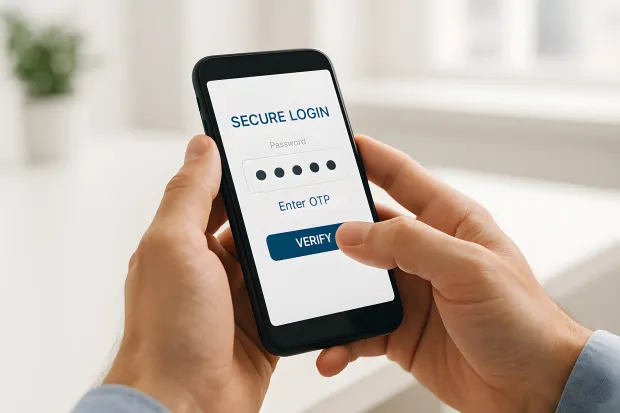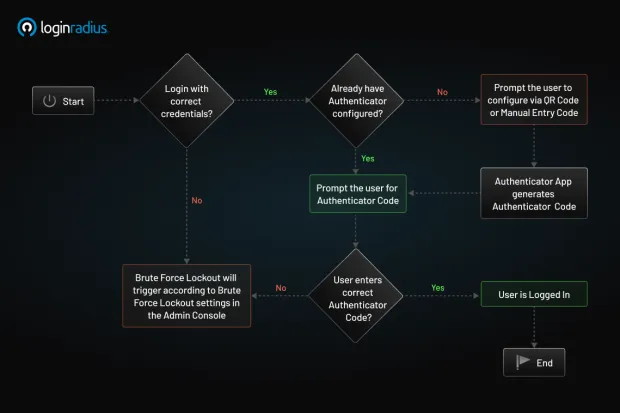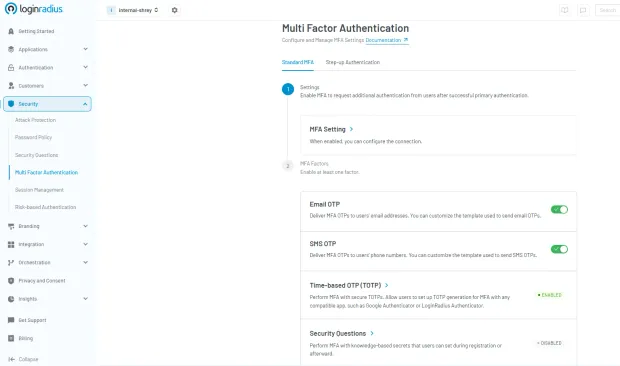Introduction
Remember when having a password alone felt secure enough? Those days are long gone. Today, hackers don’t need to break in—they trick you using phishing, data leaks, and brute-force attacks. The sheer volume of these attacks are proof enough that passwords alone can’t carry the load anymore.
That’s why most modern apps now add something extra, multi-factor authentication (MFA). One of the most popular tools in that toolbox is the one-time password (OTP). It is likely that you’ve used OTPs without even knowing. Those short codes you receive by text or email to verify your identity. But the effectiveness of all OTPs are not the same.
And when it comes to OTPs, the most secure and reliable form is TOTP, or time-based one-time password. Instead of sending data over the network, it’s generated on your device using a shared secret and the current time. Think of this shared secret as a unique, secret key/code known only by your device and the website or app.
If you’ve ever opened an app like Google Authenticator and typed in a 6-digit code that disappears after 30 seconds, you’ve used TOTP. It keeps your logins safer by making sure that even if someone steals your password, they still can’t get in.
So what makes TOTP so trusted in cybersecurity? Why are developers using it across finance, SaaS, healthcare, you name it?
And how can you start using it in your own application? Let’s walk through how TOTP authentication works, how it improves on traditional OTPs. And see how easy it is for you to set it up using LoginRadius.
What is TOTP (Time-based One-time Password)?
A time-based one-time password (TOTP) is a temporary numeric code used to verify a user’s identity during login. The code changes every 30 seconds, ensuring it’s valid for only a short time.
TOTP uses two inputs: a shared secret key (known only to the server and the user’s authenticator app) and the current timestamp. Because this algorithm is time-driven, it produces a new code at regular intervals. As a result, each passcode is short-lived, making it far more secure than static passwords or long-lasting OTPs.

This method is especially effective against phishing, credential stuffing, and brute-force attacks. Even if a TOTP code is intercepted, it becomes useless within seconds.
So, what is TOTP in cybersecurity? It’s a lightweight but powerful authentication mechanism that acts as a second layer of defense, especially in multi-factor authentication (MFA) setups. With TOTP authentication, users don’t need to rely on SMS or email-based codes. These delivery methods are often vulnerable to interception, SIM swapping, and message delays.
Instead, TOTP codes are generated locally on the user’s device using apps like Google Authenticator, Microsoft Authenticator, LoginRadius Authenticator, or Authy. Since these apps work offline, time-based one-time passwords offer better reliability and privacy compared to network-dependent alternatives.
Moreover, TOTP is built on an open standard called RFC 6238 and is widely supported by modern authentication platforms and security frameworks. It’s often compared to HOTP (HMAC-based One-Time Password), which generates codes based on a counter. For real-time login experiences, TOTP offers better usability and security, making it the de facto standard.
LoginRadius makes it easy to integrate TOTP into any identity and access management (IAM) strategy. With built-in support for TOTP MFA codes, developers can protect user sessions with minimal friction while meeting security and compliance requirements across industries.
How Time-Based One-Time Passwords Work?
The TOTP algorithm generates short-lived numeric passcodes by combining
-
a shared secret key (usually generated during user onboarding)
-
Along with the current timestamp, broken into fixed intervals, typically 30 seconds.
Both the client (i.e., the user’s authenticator app) and the server store this same secret key, and both use the same algorithm and clock to generate the code at login time.

Here’s a simplified breakdown of how time-based one-time passwords are generated:
-
Time Step Calculation:
The current Unix time (in seconds) is divided into a 30-second interval to get a time step (e.g., T = floor(current_time / 30)).
-
HMAC Hashing:
This time, step T is then combined with the secret key using HMAC (Hash-based Message Authentication Code), often using the SHA-1 hashing algorithm. The result is a secure hash.
-
Dynamic Truncation:
A subset of the hash output is selected using dynamic truncation, producing a binary string.
-
Modulus Operation:
That binary value is then converted to a 6-digit (or sometimes 8-digit) number using a modulus operation, typically % 10^6 for a 6-digit passcode.
This process happens on the client and server side alone and no codes are transmitted, which is a key reason why TOTP authentication is resilient against man-in-the-middle, phishing, and SIM swap attacks.
Because both the server and the authenticator app calculate the code using the same time window and logic, they arrive at the same code without any communication between them. If the code entered by the user matches what the server expects, authentication succeeds.
Time-Based OTP (TOTP) in LoginRadius allows users to receive one-time passcodes through an authenticator app installed on their mobile device. This provides a secure second factor of authentication after the initial login. Supported authenticator apps include Google Authenticator, Microsoft Authenticator, and LoginRadius Authenticator.
How to Enable TOTP
Here’s a step-by-step guide to quickly enable TOTP authentication through LoginRadius CIAM.
-
Navigate to Multi-Factor Authentication in the LoginRadius Admin Console
-
Toggle on TOTP
-
Configure:
- Issuer ID (name shown in authenticator app)
- QR code dimensions

When implementing TOTP authentication, the system will provide:
-
A QR code for users to scan
-
A manual entry code as a backup
After successful first-factor authentication, users will receive a response containing:
{
"SecondFactorAuthentication": {
"QRCode": http://chart.googleapis.com/chart?cht=XXXXXXXXXXXXX,
"ManualEntryCode": "XXXXXXXXXXXXXXXXXXXX",
"IsAuthenticatorVerified": false
}
}
This allows secure authentication while providing flexibility through multiple supported authenticator apps.
Why You Should Use TOTP Authentication
Credential-based attacks are becoming more frequent and more sophisticated. As a result, relying on passwords alone is no longer safe. Techniques like phishing, brute-force attacks, and credential stuffing make it easy for attackers to break in even when strong password policies are in place.
That’s why multi-factor authentication (MFA) is now considered essential for secure access. Among the various MFA options, TOTP authentication stands out for its balance of strong security and practicality.
A time-based one-time password (TOTP) is a second factor that’s both time-sensitive and generated on the user’s device. Unlike static passwords or OTPs sent via SMS or email, TOTP MFA codes are never transmitted over a network.
Instead, they’re created on the spot using a secret key and the current timestamp. This makes them immune to SIM swap attacks, message interception, and delivery failures. Because TOTP codes are generated offline, they offer clear advantages in security, privacy, and reliability.
There’s no need for third-party messaging systems or network connectivity. Users open an authenticator app like Google Authenticator, LoginRadius Authenticator, or Authy to get a code that works right away.
These apps are easy to set up, widely supported, and function seamlessly across devices and platforms. Industries with strict compliance needs, like finance, healthcare, government, and enterprise SaaS, often rely on TOTP as a trusted MFA method.
It helps meet regulatory standards such as PCI-DSS, HIPAA, and GDPR without putting user data at risk. TOTP also offers a smooth user experience. It’s fast, easy to use, and doesn’t need any special hardware or complicated steps.
Whether you're protecting customer accounts or internal tools, time-based one-time passwords deliver scalable, low-friction security even in offline or low-connectivity environments.
And with platforms like LoginRadius offering built-in support for TOTP through developer-friendly APIs and SDKs, adding this layer of protection is easier than ever. You can secure your applications without compromising performance or user experience.
Strengths of Time-Based One-Time Passwords
As cybersecurity threats grow in frequency and complexity, organizations are under constant pressure to adopt authentication methods that are both secure and scalable. Time-based one-time passwords (TOTP) have emerged as a resilient second factor, delivering robust protection against unauthorized access while remaining user-friendly and easy to implement.
Here are some of the advantages of TOTP authentication, which makes a trusted standard in modern identity security:
1. Time-Limited Codes
Every TOTP MFA code is generated with a short lifespan, typically 30 seconds. This tight time window significantly reduces the opportunity for attackers to reuse or intercept valid codes. Even if a malicious actor manages to view or capture the code, it will expire before it can be exploited.
2. Device-Based Generation
Unlike SMS or email-based OTPs, time-based one-time passwords are generated entirely on the user’s device using an app like Google Authenticator, Microsoft Authenticator, or Authy. No data is transmitted over the network, which removes attack surfaces such as SIM swapping, man-in-the-middle interception, or compromised mailboxes. This local generation approach enhances both privacy and reliability.
3. Offline Functionality
One of TOTP’s greatest advantages is that it works without an internet connection. Since codes are calculated using a shared secret and the current timestamp, no network communication is required during authentication.
This is ideal for remote employees, mobile users, or field workers operating in low-connectivity regions. Offline support also ensures that authentication remains fast and uninterrupted even during outages.
4. Compliance Alignment
For industries under regulatory pressure, such as finance, healthcare, and government, TOTP provides a standards-based solution that supports compliance with global security frameworks. It aligns with requirements from:
Implementing TOTP authentication demonstrates due diligence and a strong security posture in audit scenarios.
5. User Trust and Experience
TOTP strikes the right balance between strong security and user convenience. Authenticator apps are widely used, free to install, and require no additional hardware. The process is simple: open the app, grab the code, and log in.
When implemented through platforms like LoginRadius, TOTP becomes even more seamless, integrating directly into your existing identity flows using prebuilt APIs and SDKs. Users benefit from enhanced account protection without additional complexity or friction.
TOTP authentication is not just an enhancement, but it’s a critical component of enterprise-grade multi-factor authentication. Whether you're protecting customer accounts, internal systems, or third-party portals, time-based one-time passwords offer a scalable, secure, and user-approved solution for modern access control.
Weaknesses of Time-Based One-Time Passwords
While TOTP authentication is a strong and widely adopted security measure, it isn’t without its limitations. Developers, IT teams, and security architects should be aware of the trade-offs to design resilient systems that support both security and usability.
1. Device Dependency
TOTP MFA codes are generated locally on the user’s device using an authenticator app such as Google Authenticator or Authy. If a user loses that device, uninstalls the app, or forgets to back up the TOTP secret during setup, they’ll likely be locked out of their account. Unlike cloud-synced solutions, there’s no centralized recovery unless a backup mechanism is in place.
2. No Built-in Sync or Recovery
Most time-based one-time password apps don’t support cross-device sync or cloud-based backup by default. Users who upgrade devices or reset their phones must manually reconfigure their authenticator, which often requires access to the original secret key or QR code. Without proper re-enrollment flows, recovery becomes painful, both for users and support teams.
3. Time Sensitivity and Clock Drift
TOTP relies on tight time synchronization between the client and the server. Even minor discrepancies can result in invalid codes. While most systems introduce a small tolerance window (+30 seconds), highly desynchronized environments may still lead to failed logins and increased support overhead.
4. User Experience Gaps Compared to Push or Passkeys
Compared to passkeys or push-notification MFA methods, TOTP authentication requires more manual effort, launching a separate app, copying a code, and pasting it during login. It also lacks session-level visibility and control, such as the ability to deny a login request in real-time, which more modern approaches like FIDO2 or biometric MFA can offer.
Balance Security with Backup and Onboarding
Despite these limitations, TOTP MFA codes remain a secure, standards-based choice, especially for offline-capable, compliance-sensitive environments. To mitigate the downsides:
-
Offer backup MFA options (SMS, biometrics, recovery codes)
-
Encourage secret key export or QR code re-scan during device migration
-
Implement time sync tolerances and NTP enforcement
-
Educate users on best practices for storing recovery information
So, Is TOTP Still Worth It?
Absolutely. Even with these challenges, TOTP MFA codes offer serious protection without requiring internet access or mobile networks. They’re fast, secure, and widely supported. But to make the most of them, you’ll want to:
-
Offer clear setup instructions
-
Encourage backup code storage
-
Provide recovery options
-
Use smart time-tolerance settings
With the right support and a little user education, time-based one-time passwords can be one of the most effective ways to keep accounts secure, without making users jump through too many hoops.
OTP vs. TOTP vs. HOTP: What’s the Difference?
When implementing multi-factor authentication (MFA), it’s critical to understand the different types of one-time passwords (OTPs) and how they work. While all OTPs serve the same purpose, providing a password that’s valid for a single use, the method of generation and security level can vary significantly.
Let’s break down the three primary types: OTP, HOTP, and TOTP.
- OTP (One-Time Password)
At its core, an OTP is any password that can be used only once. It’s a broad category that includes both event-based and time-based systems. OTPs can be:
-
Sent via SMS or email,
-
Generated via apps (like authenticator apps), or
-
Delivered through hardware tokens.
While OTPs offer better protection than static passwords, their security depends heavily on how the code is generated, transmitted, and validated.
- HOTP (HMAC-Based One-Time Password)
HOTP is defined in RFC 4226 and is based on an incrementing counter. Each time the user initiates an action (such as pressing a button or requesting a login), the counter increases and a new code is generated. This code stays valid until it’s used.
Pros:
- Works well for hardware tokens where a button press triggers the OTP.
Cons:
-
Because it doesn’t expire until used, an intercepted code can still be reused.
-
Requires careful management of counter synchronization between the server and the user’s device.
In short, HOTP is secure, but slower and more prone to desync in modern web and mobile apps.
- TOTP (Time-Based One-Time Password)
TOTP improves upon HOTP by using time as the changing factor instead of a counter. Based on RFC 6238, the TOTP algorithm takes the current timestamp and a shared secret key to generate a new numeric code every 30 seconds (or other defined intervals).
Key strengths of TOTP:
-
The TOTP MFA code automatically expires after a short time, typically 30 seconds.
-
Codes are generated locally on the user’s device using apps like Google Authenticator, Authy, or Microsoft Authenticator.
-
It doesn’t rely on counters or require internet connectivity.
-
Because of its short lifespan, even if a TOTP code is intercepted, it’s almost immediately invalid.
This makes TOTP authentication ideal for login-based use cases where real-time security and user convenience matter most.
- OTP is the umbrella term. It is great in concept, but vague without knowing how it’s generated.
OTP vs. TOTP vs. HOTP: A Quick Comparison
| Feature | OTP (Generic) | HOTP | TOTP |
|---|---|---|---|
| Trigger | Varies | Counter-based | Time-based |
| Expiry | Varies | Doesn’t expire until used | Expires every 30 seconds |
| Security Risk | Medium | Can be reused if stolen | Short-lived, harder to exploit |
| Common Use Case | SMS/email codes | Hardware tokens | Mobile authenticator apps |
| Standard | Varies | RFC 4226 | RFC 6238 |
Read a more detailed comparison between HOTP and TOTP here.
SMS OTP vs. TOTP: Where Does TOTP Shine?
While SMS-based OTPs are easy to implement, they come with significant security and reliability limitations. SMS OTPs are transmitted over carrier networks, making them vulnerable to SIM swapping, interception, and delivery delays.
TOTP authentication, on the other hand, generates time-based one-time passwords locally on the user’s device using apps like Google Authenticator or Authy. These codes never travel through the network, which significantly reduces attack surfaces.
Here’s why TOTP MFA codes shine:
-
Immune to SIM swap attacks
-
Offline-capable
-
Refresh every 30 seconds for tighter security
-
More consistent user experience globally (no SMS latency)
For developers building secure authentication flows, TOTP offers a more controlled and secure method, especially when integrated through platforms like LoginRadius.
Industries Leveraging TOTP for Enhanced Security
While TOTP authentication is often associated with consumer-facing login flows, its adoption extends far beyond mobile apps and end-user accounts. Time-based one-time passwords are a cornerstone of identity verification across industries where data sensitivity, regulatory compliance, and uptime reliability are non-negotiable.
Below are key sectors that rely heavily on TOTP MFA codes to harden access control and protect critical systems.
1. Finance and Banking
In the financial sector, user trust and regulatory compliance are paramount. TOTP authentication plays a vital role in:
-
Securing online banking portals, digital wallets, and trading platforms
-
Verifying high-risk activities like fund transfers and account changes
-
Meeting industry compliance mandates such as PCI-DSS, PSD2, and GLBA
Unlike SMS-based OTPs, TOTP MFA codes are resistant to SIM swapping and man-in-the-middle attacks, making them ideal for high-value transactions and zero-trust authentication models.
A great example of this is Juhll, the agency behind Banks.com. To support secure logins and customizable registration workflows, Juhll implemented LoginRadius’ CIAM. The solution provided rapid integration, flexible social login options, and secure, encrypted data storage, all while maintaining compliance with key financial regulations.
With LoginRadius, Juhll was able to deliver a seamless and secure login experience for its users, ensuring both customer engagement and data protection at scale.
2. Healthcare and Medical Systems
Healthcare platforms are under constant pressure to protect Electronic Health Records (EHRs), patient data, and provider portals. TOTP is widely used to:
- Control access to HIPAA-regulated systems
- Authenticate doctors, nurses, and staff in clinical environments
- Offer secure login for patients accessing sensitive reports or telehealth sessions
TOTP authentication is especially valuable in offline or mobile healthcare settings, like rural clinics or emergency response teams, where network coverage is unreliable.
3. Enterprise SaaS and B2B Platforms
For SaaS and B2B organizations, especially those catering to enterprise clients, TOTP MFA codes provide an essential layer of defense around:
-
Admin dashboards and internal tools
-
Customer and partner portals
-
API access and CI/CD pipelines
Integrating time-based one-time passwords is also a key differentiator in proving security maturity to customers. Combined with identity platforms like LoginRadius, SaaS providers can roll out MFA at scale without disrupting development velocity.
Looking to enable secure partner and customer access across multiple environments? Explore how LoginRadius simplifies identity management for B2B and SaaS ecosystems in the Partner IAM overview.
4. Government and Defense
Public sector and defense organizations often operate in high-risk environments with strict operational security (OpSec) and limited connectivity. TOTP authentication is a natural fit because:
-
It works completely offline, ideal for remote locations or secure zones
-
It’s based on open standards (RFC 6238), supporting interoperability and audits
-
It enables layered access control to classified systems, internal portals, and critical infrastructure
Even in air-gapped or high-security settings, time-based one-time passwords can function reliably without introducing external dependencies.
Conclusion
In today’s threat landscape, identity is the first line of defense. TOTP authentication stands out as a proven and scalable solution. It’s built on open standards and trusted across security-conscious industries.
Time-based one-time passwords (TOTP) offer a secure alternative to delivery-based OTPs without adding friction to the login process. With TOTP MFA codes, users benefit from device-based security that doesn’t rely on SIM cards or internet access.
LoginRadius makes it easy to implement TOTP along with other MFA options. Our platform offers developer-first APIs, secure hosted login experiences, and flexible workflows. Whether you're securing customer logins, partner portals, or employee dashboards, TOTP provides a strong second factor that can scale with your identity strategy.
Want to simplify authentication? Get in touch to explore how LoginRadius can help secure your user journeys with ease.
FAQ’s
1. What is TOTP in cybersecurity?
A: TOTP is a time-sensitive code used in MFA, generated using a shared secret and the current timestamp. It refreshes every 30 seconds for added security.
2. Is TOTP secure?
A: Yes, TOTP is secure because codes are generated locally and never transmitted—making them resistant to phishing, SIM swaps, and replay attacks.
3. What is the difference between OTP and TOTP?
A: OTP is a one-time use code, often sent via SMS. TOTP is a time-based OTP that refreshes automatically every 30 seconds and works offline.
4. How do I set a one-time password?
A: Install a TOTP app, scan a QR code from your account settings, and use the 6-digit code it generates to log in securely.



